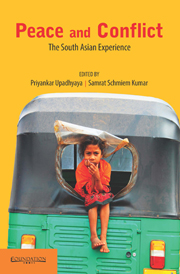Book contents
- Frontmatter
- Contents
- Foreword
- Preface
- Introduction
- 1 Conflict Resolution and Peacebuilding: Ideas, Approaches and Debates
- 2 Changing Perspectives on Peace Studies in South Asia
- 3 Peace Pedagogies in South Asia: Interreligious Understanding
- 4 Responses of Communities to Social Tension
- 5 Plurality of Peace, Non-violence and Peace Works in India
- 6 Education and Culture of Peace: Engaging with Gandhi
- 7 Structural Violence and Human Security: Gandhi's Visions
- 8 Women and the Peace Process in Nepal
- 9 Quest for Peace and Justice in Pakistan: Lawyers' Non-violent Resistance
- 10 Antinomies of Democracy and Peace in Nepal
- 11 Post-armed Conflict Trajectories in Sri Lanka
- 12 Environmental Security and Conflict in Bangladesh: Nature, Complexities and Policies
- Contributors
- Bibliography
- Index
11 - Post-armed Conflict Trajectories in Sri Lanka
Published online by Cambridge University Press: 05 October 2014
- Frontmatter
- Contents
- Foreword
- Preface
- Introduction
- 1 Conflict Resolution and Peacebuilding: Ideas, Approaches and Debates
- 2 Changing Perspectives on Peace Studies in South Asia
- 3 Peace Pedagogies in South Asia: Interreligious Understanding
- 4 Responses of Communities to Social Tension
- 5 Plurality of Peace, Non-violence and Peace Works in India
- 6 Education and Culture of Peace: Engaging with Gandhi
- 7 Structural Violence and Human Security: Gandhi's Visions
- 8 Women and the Peace Process in Nepal
- 9 Quest for Peace and Justice in Pakistan: Lawyers' Non-violent Resistance
- 10 Antinomies of Democracy and Peace in Nepal
- 11 Post-armed Conflict Trajectories in Sri Lanka
- 12 Environmental Security and Conflict in Bangladesh: Nature, Complexities and Policies
- Contributors
- Bibliography
- Index
Summary
Introduction
The armed conflict in Sri Lanka arose as a manifestation of tensions between the two main ethnic groups in the country, i.e. the Sinhalese and the Tamils with its roots dating back to the British Colonial rule. Communal Representation which was an offshoot of the ‘divide and rule policy’ employed by the British Empire in administering colonies created diminutive cracks in the otherwise harmonious Sri Lankan society. The ‘Sinhala only Act’ deepened the crevices. The approximate cause of armed conflict came about in July 1983 when militants belonging to the Liberation Tigers of Tamil Eelam (hereafter LTTE, which was one among many Tamil militant groups organized for creating a separate state for the Tamil nation in the North and East of the country) conducted an organized ambush on the Sri Lanka Army killing 13 soldiers. The events that ensued in the days thereafter are etched in the annals of modern Sri Lankan history as one of the bloodiest months the land has ever seen. Popularly known as ‘Black July’ this event is generally regarded as the commencement of full-scale hostilities between the Government of Sri Lanka (hereafter GoSL) and the LTTE.
After nearly three decades of war, the armed conflict that ravaged the economy, polity, society and culture in Sri Lanka finally came to an end on 18 May 2009 as the security forces of the Government of Sri Lanka succeeded in comprehensively defeating the LTTE which was renowned as one of the most powerful and ruthless secessionist groups. Almost the entire top leadership of the LTTE was decimated in the final phase of the military operation. The number of fatalities in the last phase of the battle is yet unknown. The Secretary, to the Ministry of Defence, has recently stated that casualties in the last phase of the war may be in the vicinity of 7000 people. Other estimates project higher numbers ranging from 10,000 to 20,000 people. It displaced internally about 275,000 people.
- Type
- Chapter
- Information
- Peace and ConflictThe South Asian Experience, pp. 200 - 220Publisher: Foundation BooksPrint publication year: 2014



